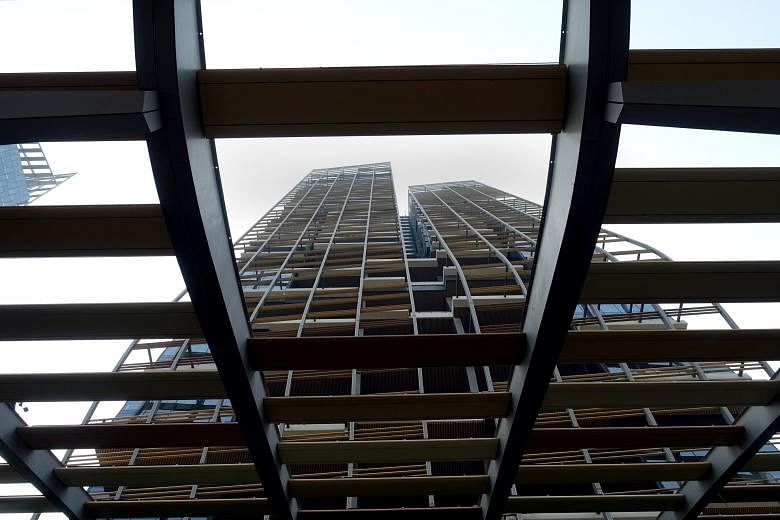After eight years that involved a venture pull-out and a financial crisis hampering its completion, the South Beach is now standing out as the glamorous new kid on the block since it opened earlier this year.
With its two soaring towers standing at 34- and 45-storeys high, four conservation buildings, a hotel as well as retail and office spaces, it is Singapore's largest mixed- development project.
Among its tenants are cool, big-name companies such as aerospace company Boeing and social- media giant Facebook which, at 70,000 sq ft, is the anchor tenant at the South Beach Tower, which houses the office spaces.
Acclaimed French designer Philippe Starck was brought into the project to inject a sense of pizzazz. The South Beach - the super-trendy 654-room, five-star hotel - is his first hotel in Singapore.
He also designed the interiors for three out of the four heritage buildings in Beach Road.
The former Non-Commissioned Officers' (NCO) Club was turned into a posh retreat filled with restaurant spaces and lounges, a cigar bar and a diving pool. It is now called South Beach Club.
For the old drill hall in the former Block 9, now renamed The Grand Ballroom, he created a stunning 11,520-light installation.
EDGY DESIGN
In general, the design and interiors get a thumbs-up from architects and designers Life interviewed. They lauded Starck's cutting-edge design as well as the building's green features.
While most of the building is up and running, the retail portion - to open only next year - gets a more cautious response by analysts in mall-saturated Singapore.
Spread over a 3.5ha plot parcelled by Beach Road, Bras Basah Road, Middle Road and Nicoll Highway, South Beach was designed by architects Foster + Partners.
The $3-billion project is a joint venture between City Developments Limited and IOI Properties Group Berhad that forms the South Beach Consortium.
Industry watchers say Starck's daring, jazzy designs are shaking up a relatively staid hospitality industry.
Mr Alan Barr, 41, founder and managing director of greymatters, a design agency which specialises in hospitality and interiors, says Starck's hotel will appeal to those "who crave design with attitude and perspective".
For example, the lobby is fronted by a 7m-by-6.5m video wall that features animated colourful graphics, while the hotel is decorated with artworks such as 160 LED-lit flame candles hanging over a Starck-designed sofa.
Mr Barr adds: "In the sea of ordinary, safe and conservative hotels of Singapore, it is refreshing to see developers take a step off the ledge of conservatism."
The project has also been lauded for incorporating green features and has won two Green Mark Platinum Awards. In particular, a microclimatic canopy, which runs the length of the property, has been engineered to harvest rainwater and is fitted with cells to convert solar energy into electricity.
This very canopy came under debate when the first designs for South Beach were revealed.
In 2007, The Straits Times reported that some Singapore architects expressed dismay that the design threatened to obscure the original facades of the gazetted military buildings - as if it was "ashamed of the old architecture".
Assistant Professor Chong Keng Hua, 38, of Singapore University of Technology and Design's architecture and sustainable design pillar, credits the architects for listening to the concerns. Now, the heritage buildings stand without being covered by the canopy.
However, he wishes that "more thought could be given to adaptive reuse of conserved buildings to relate to the original social-cultural meanings of the site".
The cluster of three blocks in South Beach was the venue for the first national service enlistment in 1967 and is an important part of local military history.
While the South Beach Consortium is still studying how best to use the former NCO Club, Prof Chong says: "Right now, there seems to be a disconnect from the past. A common way would be to turn some of the spaces into a museum or gallery."
Other possibilities would be to open up some areas for programmes that fit into the history of the buildings, such as fitness activities, he adds.
LUXE LIVING, TOUGH RETAIL
Meanwhile, the property sector has its eye on South Beach Residences, a 190-unit luxury condominium which sits between levels 23 and 45 of the South Tower. The 99-year leasehold property is due to be completed next year.
Here, residential units range from 950 sq ft for a two-bedroom unit to 6,500 sq ft for a five-bedroom penthouse. Each penthouse has its own swimming pools.
While prices are not out yet, the developer turned down an offer of $26 million for one of its penthouses last year.
Mr Nicholas Mak, executive director of SLP International Property Consultants, says that the demand in the local luxury residential market is badly hampered by the property curbs.
But he adds that one of South Beach's advantages is that not many high-rise condominiums are in the area. Moreover, none of them is freehold, so South Beach's 99-year tenure would not be a disadvantage in comparison.
Regarding South Beach's retail potential in mall-rich Singapore, analysts are having mixed feelings about the 40,000 sq ft of retail space opening by the second half of next year.
Called South Beach Avenue, this retail portion is spread over the sunken plaza in basement one and the first level and will be linked directly to the Esplanade MRT station.
Already, 14,400 sq ft of space has been leased.
The major tenant is lifestyle group Massive Collective, which is taking up Block 1, a 13,000 sq ft former armoury now renamed South Beach Quarter. The two- storey building now houses a club, a bar and two restaurants.
Last year, the consortium said it was targeting "mid-tier to high-end retailers" and was talking to international names and celebrity chefs.
Ideas such as launching a gourmet food market hall, which could be helmed by renowned Italian food emporium Eataly, for example, were also bandied around.
Ms Sulian Tan-Wijaya, senior director for retail and lifestyle at Savills Singapore, believes "the delays had affected its ability to attract retailers".
"Retailers are not expanding as much as two to three years ago and many are even consolidating. Timing-wise, it may have lost out to Suntec City and Marina Square, which were completed earlier."
South Beach's neighbour Suntec City recently completed a three-year makeover to include new retail spaces, which now stand at 960,000 sq ft.
Anchor tenants there include international fashion brands H&M and Uniqlo.
Marina Square, a stone's throw away, also added a new dining wing in 2013 and launched a 34,000 sq ft Japanese food emporium two months ago.
Ms Tan-Wijaya adds that South Beach should focus on having a strong cluster of restaurants, cafes and bars to draw crowds beyond the vicinity.
Associate Professor Prem Shamdasani, 56, from the National University of Singapore Business School, whose speciality is in marketing and retail strategy, says South Beach should market itself as a "destination location".
"South Beach is an iconic development in the heart of town - it is already creating a buzz that is lacking in that area.
"Having the same brands as others is a safe strategy, so it has to work hard and be creative with the mix. Retail is never going to be easy in Singapore."
MORE STORIES see:



